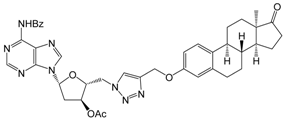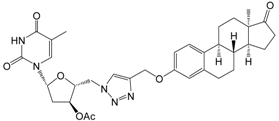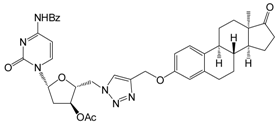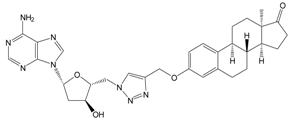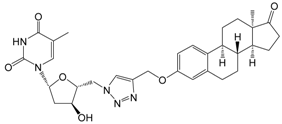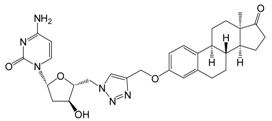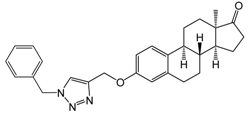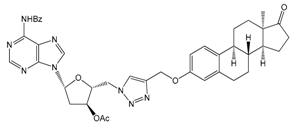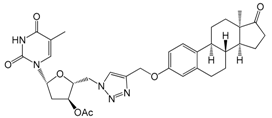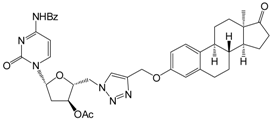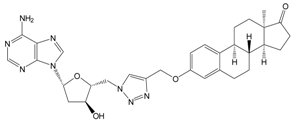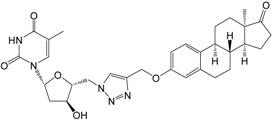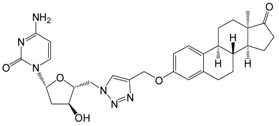Abstract
2′-Deoxynucleoside conjugates of 13α-estrone were synthesized by applying the copper-catalyzed alkyne–azide click reaction (CuAAC). For the introduction of the azido group the 5′-position of the nucleosides and a propargyl ether functional group on the 3-hydroxy group of 13α-estrone were chosen. The best yields were realized in our hands when the 3′-hydroxy groups of the nucleosides were protected by acetyl groups and the 5′-hydroxy groups were modified by the tosyl–azide exchange method. The commonly used conditions for click reaction between the protected-5′-azidonucleosides and the steroid alkyne was slightly modified by using 1.5 equivalent of Cu(I) catalyst. All the prepared conjugates were evaluated in vitro by means of MTT assays for antiproliferative activity against a panel of human adherent cell lines (HeLa, MCF-7 and A2780) and the potential inhibitory activity of the new conjugates on human 17β-hydroxysteroid dehydrogenase 1 (17β-HSD1) was investigated via in vitro radiosubstrate incubation. Some protected conjugates displayed moderate antiproliferative properties against a panel of human adherent cancer cell lines (the protected cytidine conjugate proved to be the most potent with IC50 value of 9 μM). The thymidine conjugate displayed considerable 17β-HSD1 inhibitory activity (IC50 = 19 μM).
1. Introduction
Estrogens are synthesized biochemically in a multistep process from cholesterol in human body [1], and are responsible for the development of secondary sexual characteristics in females and maintenance of central nervous system, cardiovascular system and bones. Since they play a crucial role in the cell proliferation, overproduction of estrogens may lead to enhanced proliferation of hormone sensitive cells, resulting in hormone dependent cancers: ovarian, uterine, breast, prostate and endometrial [2]. Estrone-based anticancer drugs have been developed as antiproliferative/antihormonal or cytotoxic agents acting on non-hormonal targets [3]. Antiproliferative estrogens exert their activity as enzyme inhibitors or as antiestrogens (acting through their receptors). Although the proliferation process is rather complex, one of potential enzymes which plays crucial role in the proliferation process of some cancer cell types is the human 17β-hydroxysteroid dehydrogenase 1 (17β-HSD1). It catalyzes the reduction of estrone to 17β-estradiol, which enhances the proliferation of certain cancer cells [4]. High activity of this isozyme can be detected in female reproductive tissues, e.g., in the ovaries and in the placenta [5]. 17β-HSD1 has been found to be responsible for the local overproduction of 17β-estradiol in various breast cancers and ovarian cancers [6]. The inhibition of 17β-HSD1 with suitable pharmacons decreases synthesis of 17β-estradiol and causes significant estrogen deprivation and antitumor effect in hormone dependent cancers, therefore 17β-HSD1 inhibitors could be promising candidates of anti-estrogen therapy [7,8]. Regardless of the mechanism of antiproliferative action, there is a general requirement in the development of all estrone-based anticancer drugs: the lack of estrogenic activity. Chemical modifications of estrone may lead to compounds lacking hormonal behavior [3,9,10]. Substitution at C-2, opening of ring D or inversion at C-13 of the estrane skeleton usually leads to the loss of estrogenic activity [11,12,13,14,15,16]. 13α-Estrone may be an excellent scaffold for the design of hormonally inactive agents having antiproliferative activity and fortunately it is readily available from native 13β-estrone by the method of Yaremenko and Khvat, using 1,2-phenylenediamine and acetic acid [17]. We recently published 13α-estrone, 1,2,3-triazolyl 13α- and d-secoestrone derivatives possessing substantial cytostatic and/or 17β-HSD1 inhibitory properties [18,19,20,21,22]. 13α-Estrone itself exerted outstanding 17β-HSD1 inhibitory activity with an IC50 value comparable to that of the reference estrone [22]. Concerning the triazoles, the heterocyclic ring was introduced to C-3 or to C-16 directly or via a short linker. The cell growth-inhibitory potential depended on the position of the triazolyl moiety and on the nature of the functional group at C-3. 3-Hydroxy or 3-ether derivatives displayed lower cytostatic potentials than their 3-O-[(1-benzyl-1H-1,2,3-triazol-4-yl)methyl] counterparts. The latter triazoles displayed one order of magnitude higher activities (submicromolar IC50 values) than the earlier described potent 16-triazolyl 3-O-benzyl ethers [18]. It can be stated that concerning the antiproliferative behaviour of triazolyl 13α-estrones, functionalization at C-3 over C-16 seems more preferential. One of the most potent antiproliferative compounds was 3-O-[(1-benzyl-1H-1,2,3-triazol-4-yl)methyl]-13α-estrone bearing intact ring D (1, Figure 1). Based on its remarkable cytostatic potential (IC50 = 0.3–0.9 μM, [20], this 13α-estrone triazole conjugate (1) may be used as a model compound for further derivatization with dual aim: to improve its cell growth-inhibitory potential to nanomolar scale, and to enhance its tumor selectivity. A potential route to enhance this selectivity is to prepare bioconjugates. Our recent results suggest that the triazole ring at 3-O should remain to retain the biological activity, but the azide counterpart used in the CuAAC reaction may be another biomolecule, such as a nucleoside.
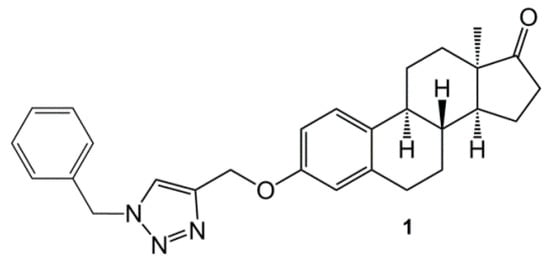
Figure 1.
Structure of 3-O-[(1-benzyl-1H-1,2,3-triazol-4-yl)methyl]-13α-estrone.
The advantage of using a nucleoside azide could be either the higher activity on targeted enzymes overrepresented in cancer cells or an enhanced cellular uptake of the bioconjugates in these cells compared to the healthy ones. As the cancer cells require higher amount of nucleoside building blocks for their proliferation, they have significantly higher uptake of nucleosides by the different nucleoside transporters [23,24,25]. The nucleoside–steroid bioconjugates, which have been synthesized so far for anticancer purposes contain the nucleoside units as the bioactive components, like 2′-deoxy-5-fluorouridine or coenzyme mimics in bisubstrate inhibitors [26,27]. However, to our knowledge nucleosides, which can selectively enhance the transport into the cancer cells, are not used as targeting carriers.
Therefore our aim was to test this possibility in case of an estrone derivative with established antiproliferative activity. If the coupled nucleoside unit increases the active transport of the steroid molecule without effecting the antiproliferative activity of the steroid part, one should see an increased inhibition of cell growth.
The connection types applied in the nucleoside–steroid conjugates prepared so far are generally ester bonds [26,28,29,30,31]. On the other hand, in case of conjugates of polyfunctional biomolecules, the CuAAC method is a widely used alternative [32,33] which forms a stable 1,2,3-triazole ring. 1,2,3-Triazoles (for sake of simplicity hereinafter referred to as “triazoles”; systematic compound names are given in the Materials and Methods section) are extensively used linkers in synthetic bioactive conjugates because of their stability against metabolic degradation and their favourable hydrogen-bonding properties. Incorporation of a triazole ring into the estrane skeleton has additional advantages: it may enhance the water solubility, bioavailability and as mentioned above this structural moiety enhanced the antiproliferative activity of an estrone derivative [18]. The CuAAC is a highly selective coupling method [34] which requires an azide and an alkyne function on the biomolecules and copper(I) ion as a catalyst.
In our case two potential approaches can be considered for the introduction of alkyne and azide moieties suitable for CuAAC reaction: (1) the nucleosides contain the azido group and the steroid has a terminal alkyne function or (2) the nucleosides have the terminal alkyne functional group and the steroid contains the azide. The formation of an alkynyl ether function on the phenolic OH group of an estrone derivative is not problematic, but the derivatization of nucleosides is not as straightforward as it seems. Regarding the first possibility, the preparation of 5′-azido-5′-deoxy nucleosides in the commonly used two-step method (5′-O-activation by introduction of tosylate [35,36,37,38,39], mesylate [38], halogen [35,39,40,41,42,43,44,45,46] or other leaving group [47,48] followed by azide substitution is hampered by several side-reactions and variable yields. The most relevant side-reactions are 3′,5′-bis-O-tosylation, 3′,5′-diazide formation [35], 4′,5′-elimination and 2,3′/5′-anhydronucleoside formation (in the case of pyrimidine nucleosides) [43,47]. As a rule, the yields of these transformations are highly dependent on the identity of nucleobase (cytidine and especially guanine are troublesome) [37,41,42,43,45,47], configuration of sugar moiety [35,49], protecting group pattern [36] of the nucleobase and the sugar, steric congestion [40,44] and the actual method used [39,46,48]. Hence, the overall yields of these reactions are usually not very high, generally around 40%–60% or even lower (Scheme 1, path a).
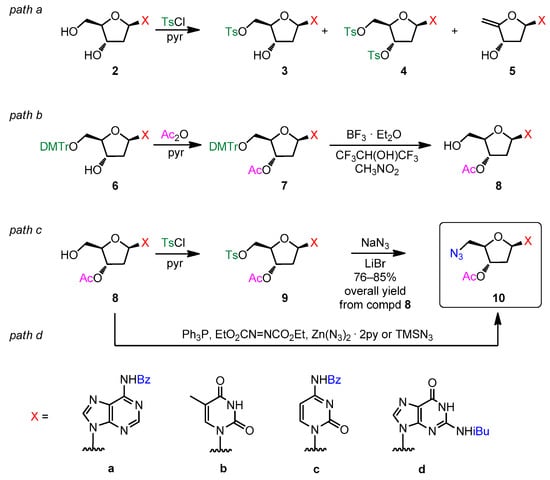
Scheme 1.
Synthesis of 5′-azido-2′,5′-dideoxynucleosides.
Alternatively, Mitsunobu reaction [50,51,52] with hydrogen azide, trimethylsilyl azide or zinc azide-pyridine complex [53] is also a possible alternative to prepare azides from nucleosides, provided that the senstive sugar moieties survive these conditions (Scheme 1, path d).
The second possibility (alkynylation of nucleosides) is also problematic: low yields [54,55,56,57,58], concomintant O,N-dialkylation hamper the effective derivatization of nucleosides [57,58]; it was also observed that cation chelation and solvents greatly influence the outcome of the reactions [59].
Here we chose the above mentioned 13α-estrone as a starting compound with the aim of synthesizing nucleoside bioconjugates and we planned to investigate the antiproliferative properties and potential 17β-HSD1 inhibitory effect of these conjugates. Based on our earlier experience in the preparation and in vitro biological assays of triazolyl 13α-estrone derivatives with anticancer activity, we have opted for the 3-hydroxy group of 13α-estrone for the introduction of the terminal alkyne function. On the nucleosides the 5′-hydroxy seems to be the best choice because its chemical reactivity is higher than that of 3′, and also the better biocompatibility, as the nucleosides in the cells are mainly derivatized on their 5′-end. Hence, it is more likely that the recognition of the nucleosides on the receptor, enzyme and transporter proteins are favoured in case the nucleosides are only modified on their 5′-end and the rest of the nucleosides are freely available for the proteins.
2. Results and Discussion
2.1. Preparation of 5′-Azido-2′,5′-dideoxynucleosides
For the preparation of 5′-azido-2′,5′-dideoxynucleosides, first we have followed the tosyl–azide replacement method based on the literature but the isolated yields were significantly lower in our hands (Scheme 1, path a) compared to those described in the literature [35,36,37,38,39] therefore we decided to protect the 3′-hydroxy groups (Scheme 1, path b). Although the 3′-protection requires two more steps (3′-O-acylation and 5′-O-deprotection when the starting material is a 5′-O-(4,4′-dimethoxytrityl (DMTr))-N-acyl-protected nucleoside), it helps avoid the bis-3′,5′-O-tosylation and increases the solubility of the nucleosides which might also be a reason of the low yields. We have chosen the acetyl-protection of the 3′-hydroxy because it was considered to be compatible with the final deprotection of the steroid–nucleoside conjugates. The crude acetylated material was used for the 5′-O-DMTr deprotection without chromatographic purification. As a commonly used 3% trichloroacetic acid/dichloromethane deprotection resulted in a considerable amount of depurination side-products (mainly in the case of 2′-deoxyadenosine) therefore we have changed the reagent to a deprotection mixture containing the Lewis acid boron trifluoride in a 1,1,1,3,3,3-hexafluoroisopropanol–nitromethane solution [60] (Scheme 1, path b).
Using the 5′-OH containing, 3′-O-acetyl-protected nucleosides (8a–d) we have carried out the 5′-O-tosylation in pyridine at room temperature and after purification the tosyl–azide exchange reaction in DMF at 50 °C (Scheme 1, path c). We have obtained better yields compared to the ones without 3′-O-protection but the yields were still not too high, around 50%. Moreover, in case of 2′-deoxguanosine, the tosylation reaction gave a very low yield (<10%), probably due to the very poor solubility. Therefore we stopped our attempts to obtain the tosylate 9d and its further derivatization was also abandoned.
As we were not satisfied with the isolated yields of azidonucleosides we attempted to improve them by applying Mitsunobu reaction to obtain the 5′-azides directly in a one-step reaction from the 3′-O-acetyl-protected nucleosides (Scheme 1, path d). The Mitsunobu reaction requires an acid component which should be HN3 in our case but we did not want to use a Brønsted acid to avoid the potential glycoside bond cleavage therefore, instead of the protic acid, we have tried two Lewis acids, Zn(N3)2 2 py or trimethylsilyl azide which were also used for Mitsunobu reactions [50,51,52,53]. Although we have tried to optimize the reaction conditions by varying the starting materials (2′-deoxyadenosine, thymidine, 2′-deoxycitidine, 2′-deoxyguanosine,), the azodicarboxylate reagents (diethyl or diisopropyl esters), the azide-containing acids and also applying different temperatures (0 °C and room temperature), we were unable to detect a considerable amount of 5′-azido-2′,5′-dideoxynucleosides. Only in case of 2′-deoxyadenosine we have got a 20% of the desired product, by using trimethylsilyl azide reagent at 0 °C in a 1 h reaction time. In all other cases only the 5′-O-trimethylsilylated nucleoside side-products were found by mass spectrometry analyses of the newly appearing TLC spots. These side-products have decomposed during the work up procedure giving back the starting nucleosides. As the Mitsunobu reaction failed to produce the desired 5′-azido-2′,5′-dideoxynucleosides, we eventually have used the 3′-O-protected–tosyl–azide exchange route to prepare the required amounts of 5′-azido-2′,5′-dideoxynucleosides 10a–c for the conjugation reactions from crude tosylates 9a–c (Scheme 1, path c).
2.2. Optimization of the Click Reaction between 5′-Azido-nucleoside Derivatives and 3-O-Propargyl-13α-estrone
The 5′-azido-2′,5′-dideoxynucleosides 10a–c were connected to 3-O-propargyl-13α-estrone (11) [20] in a CuAAC reaction (Scheme 2). The solvent of the click-reaction was toluene (thymidine and adenosine) or anhydrous tetrahydrofuran (cytidine) due to solubility problems. Initially, we have followed the commonly used literature method (catalytic amounts of copper(II) salts in the presence of sodium ascorbate, aq. tert-butanol at room temperature) [32] but to no avail (Table 1). Alternative methods [36,38,61], using 0.01-0.2 equivalent of copper(I) iodide catalyst along with 0.2 equivalent of triphenylphosphane and DIPEA have also been tested but the reaction did not proceed well even if higher temperature, different solvents and prolonged reaction times (3 days) were applied. The highest reaction temperature was limited to as high as 50 °C, to avoid the potential side-reactions on the nucleoside part. We supposed that the reason of the very low yields (<30% according to TLC monitoring) could be the high complex-forming affinity of the N-acyl-protected nucleosides which trapped the Cu(I) ion catalysts [54]. Application of inert argone athmosphere did not improve the yield. Therefore we increased the amount of the Cu(I) catalyst and DIPEA to 1.5 equivalent and eliminated triphenylphosphane from the reaction mixture. With this modified method all conjugation reactions were complete in one day at 50 °C according to TLC and the final isolated yields of protected conjugates 12a–c were acceptable (Table 1).

Scheme 2.
CuAAC conjugation reaction of 3′-O-acetyl-5′-azido-2′,5′-dideoxynucleosides and 3-O-propargyl-13α-estrone.

Table 1.
Optimization of CuAAC conjugation reaction of 3′-O-acetyl-5′-azido-2′,5′-dideoxy- nucleosides and 3-O-propargyl-13α-estrone.
2.3. Optimization of the Deprotection of Conjugates (Nucleobase N-Benzoyl and 2′-Deoxy-D-ribose-3′-O-acetyl Deprotection)
The synthesized bioconjugates contained the 3′-O-acetyl and N-benzoyl protecting groups on the nucleoside moiety which helped increase the solubility in the synthetic reactions but for the biological experiments we needed the unprotected nucleoside conjugates. Aqueous ammonia is commonly used for the deprotection of these protecting groups in the nucleic acid chemistry but the protected conjugates were not soluble in the aqueous media therefore this deprotection method failed. We have tested the Zemplén deacetylation protocol using 0.1 M of sodium methylate in methanol but only the acetyl group was removed from the 3′-hydroxy group. Finally, 4 M ammonia solution in methanol was used at 50 °C which removed all the acyl protecting groups of the conjugates in 16 h to yield derivatives 13a–c.
2.4. Antiproliferative Activities
The antiproliferative properties of the newly synthesized nucleoside conjugates were characterized in vitro on a panel of human adherent cancer cell lines (HeLa, MCF-7 and A2780) by means of MTT assays. Structurally similar estrone analogs earlier exhibited growth inhibitory activity against these cells [9,18,19,20,21]. The influence of the nature of the protected or unprotected nucleoside moiety on the cytostatic properties was investigated and the results are shown in Table 2. The protected cytidine conjugate 12c proved to be the most potent with IC50 values in the range 9.0–10.4 μM, although this value is an order of magnitude higher than the value of the 13α-estrone triazole 1 [20]. The removal of the benzoyl and/or acetyl protecting groups from the nucleoside–13α-estrone conjugates 12a–c resulted in unprotected conjugates 13a–c with generally reduced cytostatic properties. Although we do not know the mechanism of action of our conjugates, but compared to the reference steroid 1, the non-polar benzyl group was replaced by the polar deoxynucleoside units, therefore the lower activity could be due to the more pronounced steric effect and polar properties of the nucleoside units. Interestingly, the conjugates containing less polar but larger protected nucleosides gave higher antiproliferative activity than the unprotected, more polar but smaller nucleoside-containing ones. This fact highlights the importance of both the limited size and non-polar characteristics of the group at C-3 triazolyl moiety of 13α-estrone. On the other hand, this finding also suggests that the hypothesized, potentially selective increase in the uptake of nucleoside conjugates of the estrone derivative might not be operative. The reason of the lower overall uptake could be the decrease of the passive transport of the more polar, nucleoside–estrone derivative through the cell membrane. If the passive transport has much higher contribution to the overall uptake than the nucleoside transporter mediated routes, then the loss of antiproliferative activity of the more polar, unprotected nucleoside–13α-estrone conjugates can be explained by lower concentration of the conjugates inside the cell. Either explanation is true, unfortunately the triazolyl-deoxynucleoside modification of 13α-estrone on C-3 position did not help improving the antiproliferative activity of the model compound 1.

Table 2.
Antiproliferative properties of the synthesized compounds. Mean value from two independent determinations with five parallel wells; standard deviation <15%.
2.5. Inhibition of 17β-HSD1
The newly synthesized nucleoside conjugates 12a–c and 13a–c of 13α-estrone were tested against the human 17β-HSD1 in vitro. The results in Table 3 show that only the unprotected thymidine conjugate 13b exerted any substantial inhibition, with an IC50 value of 19 μM. Other tested conjugates displayed weak inhibition. Compared to our previous results on 13α-estrone and its 3-methyl ether, these conjugates showed lower inhibitory effect, similar to those of the 3-benzyl ether of 13α-estrone [22]. The decrease in the inhibitory potential of nucleoside conjugates is probably caused by the steric effect of the larger nucleoside–triazolyl unit on the C-3 position.

Table 3.
Inhibition results on 17β-HSD1. Relative conversions (control incubation with no inhibition is 100%) measured in the presence of 10 μM of the compound tested. IC50: The inhibitor concentration that decreases the enzyme activity to 50%. SD: standard deviation (for relative conversion n = 3).
3. Materials and Methods
3.1. Chemistry
Melting points (mp) were determined on an IA8103 apparatus (Electrothermal, Stone, UK) and are uncorrected. The reactions were monitored by TLC on Kieselgel-G (Si 254 F, Merck, Darmstadt, Germany) layers (0.25 mm thick); solvent systems (ss): (A) EtOAc, (B) EtOAc/methanol (9:1 v/v), (C) toluene/isopropanol (1:1 v/v). The conjugates were detected by spraying with 5% phosphomolybdic acid in 50% aqueous phosphoric acid. For the identification of azides the TLC was placed in a 10% solution of triphenylphosphane in CH2Cl2 for 2 min, then sprayed with ninhydrine solution (0.5% ninhydrine and 5 mM NaOH in ethanol/water 3:1 v/v).The Rf values were determined for the spots observed by illumination at 254 nm. Flash chromatography: Merck silica gel 60, 40–63 μm. All solvents were distilled prior to use. Reagents and materials were obtained from commercial suppliers and were used without purification. Elementary analysis data were determined with a CHN analyzer model 2400 (Perkin Elmer, Waltham, MA, USA). NMR spectra were obtained at room temperature with a DRX 500 instrument (Bruker, Rheinstetten, Germany). Chemical shifts are reported in ppm (δ scale), and coupling constants (J) in Hz. For the determination of multiplicities the J-modulated spin-echo pulse sequence was used. Mass spectra were recorded on a MAT TSQ 7000 instrument (Finnigan, Waltham, MA, USA) equipped with an electrospray ion source, using the following parameters: positive ionization mode, nebulizing gas N2 (3.45 bar), capillary temperature: 200 °C, capillary voltage: 4500 V and an acetonitrile–water 1:1 (v/v) mixture containing 0.1% trifluoroacetic acid as eluent. The samples were dissolved in acetonitrile and injected directly. The base peaks were usually the [M + H]+ signals along with far less abundant [2M + H]+ signals.
3.1.1. General Procedure for Synthesis of 3′-O-Acetyl-N-acyl-protected-2′-deoxynucleosides 8a–d
10 mmol of 5′-O-DMTr-N-acyl-protected-2′-deoxynucleoside 6a, 6b, 6c or 6d was dissolved in pyridine (50 mL) and Ac2O (10 mmol, 945 μL) was added. The reaction mixture was stirred at 0 °C for 4 h, evaporated in vacuo, redissolved in EtOAc (100 mL) and extracted with water (2 × 100 mL). The combined organic layers were dried over Na2SO4 and evaporated in vacuo. The resulting crude product 7a, 7b, 7c or 7d was directly used for the next step without further purifications.
10 mmol of 5′-O-(4,4′-dimethoxytrityl)-3′-O-acetyl-N-acyl-protected-2′-deoxynucleoside 7a, 7b, 7c or 7d was dissolved in nitromethane (20 mL) and a mixture of 1,1,1,3,3,3-hexafluoroisopropanol (20 mL, 190 mmol), boron trifluoride diethyl etherate (247 μL, 2 mmol) and triethylsilane (6 mL, 38 mmol) was added. The reaction mixture was stirred at room temperature overnight, then 10% aqueous NaHCO3 solution was added and evaporated in vacuo. The resulting crude product was purified by column chromatography with EtOAc as eluent to give the corresponding nucleoside 8a, 8b, 8c or 8d.
3.1.2. General Procedure for Synthesis of 3′-O-Acetyl-5′-azido-N-acyl-protected-2′,5′-dideoxy-nucleosides 10a–c
3′-O-Acetyl-N-acyl-protected-2′-deoxynucleoside 8a, 8b, 8c or 8d (1 mmol) was dissolved in pyridine (15 mL) and p-toluenesulfonyl chloride (285 mg, 1.5 mmol) was added. The reaction mixture was stirred at room temperature overnight, evaporated in vacuo, redissolved in EtOAc (100 mL) and extracted with 1% aqueous KHSO4 solution (2 × 100 mL). The combined organic layers were dried over Na2SO4 and evaporated in vacuo. The resulting crude product was purified by column chromatography with EtOAc as eluent to afford the tosylated nucleoside 9a, 9b, 9c or 9d.
3′-O-Acetyl-N-acyl-protected-2′-deoxy-5′-O-tosylnucleoside 9a, 9b or 9c (1 mmol) was dissolved in dry DMF (20 mL) then sodium azide (195 mg, 3 mmol) and lithium bromide (261 mg, 3 mmol) were added. The reaction mixture was stirred at 50 °C for 6 h. The reaction mixture was evaporated in vacuo, redissolved in EtOAc and extracted with water (2 × 100 mL). The combined organic layers were dried over Na2SO4 and evaporated in vacuo. The resulting crude product was recrystallized from EtOAc to yield azidonucleoside 10a, 10b or 10c.
3′-O-Acetyl-5′-azido-6-N-benzoyl-2′,5′-dideoxyadenosine (10a): After purification, 10a was obtained as a white solid (346 mg, 82%), m.p. 135–136 °C, Rf = 0.29 (ss A); 1H-NMR (CDCl3); δ [ppm] = 2.11 (s, 3H, 3′-OAc), 2.63 (d, 1H, J = 8.0 Hz) and 3.27 (m, 1H): 2′-H2, 3.61 (d, 1H, J = 11.5 Hz) and 3.76 (d, 1H, J = 12.0 Hz): 5′-H2, 4.27 (s, 1H), 5.39 (s, 1H), 6.54 (m, 1H): 1′-, 3′-, 4′-H, 7.55 (t, 2H, J = 2 × 7.0 Hz), 7.64 (d, 1H, J = 7.5 Hz), 8.06 (d, 2H, J = 7 Hz): benzoyl protons, 8.74 (s, 1H) and 8.79 (s, 1H): 2-H and 8-H, 11.23 (s, 1H, 6-NH); 13C-NMR (CDCl3); δ [ppm] = 20.7 (3′-OAc), 35.0 (C-2′), 51.5 (C-5′), 74.6, 82.9, 83.8, 125.9 (C-5), 128.3 (2C), 128.4 (2C), 132.4: benzoyl CHs, 133.2: benzoyl Cq, 143.3 (C-8), 150.4 (C-4), 151.9 (C-6), 152.3 (C-2), 165.5 (Bz-CO), 170.0 (Ac-CO); ESI-MS: 423 [M + H]+; Anal. Calcd for C19H18N8O4: C, 54.03; H, 4.30; N, 26.53. Found: C, 53.96; H, 4.47; N, 26.95.
3′-O-Acetyl-5′-azido-5′-deoxythymidine (10b): After purification, 10b was obtained as a white solid (263 mg, 85%), m.p. 115–116 °C, Rf = 0.65 (ss A); 1H-NMR (CDCl3); δ [ppm] = 1.57 (s, 3H, 5-CH3), 1.83 (s, 3H, 3′-OAc), 2.02 and 2.27 (2 × m, 2 × 1H, 2′-H2), 3.40 (m, 2H), 3.86 (d, 1H, J = 2.0 Hz), 4.91 (d, 1H, J = 3.5 Hz), 5.95 (t, 1H, J = 10.0 Hz, J = 5.0 Hz): 1′-, 3′-, 4′-H, 5′-H2, 7.33 (s, 1H, 6-H), 11.16 (s, 1H, 3-NH); 13C-NMR (CDCl3); δ [ppm] = 12.0 (5-CH3), 20.7 (3′-OAc), 35.0 (C-2′), 51.6 (C-5′), 74.1, 81.9, 83.9, 109.9 (C-5), 135.9 (C-6), 150.4, 163.6, 170.0 (Ac-CO); ESI-MS: 310 [M + H]+; Anal. Calcd for C12H15N5O5: C, 46.60; H, 4.89; N, 22.64. Found: C, 46.82; H, 5.02; N, 22.83.
3′-O-Acetyl-5′-azido-4-N-benzoyl-2′,5′-dideoxycytidine (10c): After purification, 10c was obtained as a white solid (302 mg, 76%), m.p. 146–147 °C, Rf = 0.32 (ss A); 1H-NMR (CDCl3); δ [ppm] = 2.11 (s, 3H, 3′-OAc), 2.53 (m, 2H, 2′-H2), 3.77 (dd, 2H, J = 9.5 Hz, J = 12.0 Hz, 5′-H2), 4.25 (s, 1H), 5.21 (s, 1H), 6.24 (d, 1H, J = 4.5 Hz): 1′-, 3′-, 4′-H, 7.42 (s, 1H, 5′-H), 7.54 (d, 2H, J = 5.5 Hz), 7.65 (d, 1H, J = 5.5 Hz), 8.04 (m, 2H): benzoyl protons, 8.24 (s, 1H, 6’-H), 11.34 (s, 1H, 4′-NH); 13C-NMR (CDCl3); δ [ppm] = 20.7 (3′-OAc), 36.6 (C-2′), 51.6 (C-5′), 74.3, 82.7, 86.5, 96.6 (C-5), 128.3 (2C), 128.4 (2C), 132.7: benzoyl CH-s, 133.1: benzoyl Cq, 145.2 (C-6), 154.1 (C-2), 163.6 (C-4), 165.1 (Bz-CO), 170.0 (Ac-CO); ESI-MS: 399 [M + H]+; Anal. Calcd for C18H18N6O5: C, 54.27; H, 4.55; N, 21.10. Found: C, 54.18; H, 4.63; N, 19.85.
3.1.3. General Procedure for Click Reactions: Preparation of 12a–c
Azidonucleoside 10a, 10b or 10c (0.15 mmol) was dissolved in toluene (10 mL) or THF (10mL), CuI (0.225 mmol, 42.75 mg, 1.5 equiv.), DIPEA (78 μL, 0.45 mmol, 3 equiv.) and 3-O-propargyl-13α-estrone 11 [20] (0.165 mmol, 1.1 equiv.) were added to the reaction mixture and it was stirred for overnight at 50 °C. Then the mixture was evaporated in vacuo, the resulting crude product was purified by column chromatography with EtOAc as eluent to yield protected conjugate 12a, 12b or 12c.
3-{[1-(3′-O-Acetyl-6-N-benzoyl-2′,5′-dideoxyadenosine-5′-yl)-1H-1,2,3-triazole-4-yl]methyl-oxy}-13α-estra-1,3,5(10)-trien-17-one (12a): After purification, protected conjugate 12a was obtained as a white solid (78 mg, 68%), m.p. 141–143 °C, Rf = 0.55 (ss B); 1H-NMR (CDCl3); δ [ppm] = 1.00 (s, 3H, 18-CH3), 1.89 (s, 3H, 3′-OAc), 2.27 (dd, 2H, J = 10.5 Hz, J = 12.5 Hz, 2′-H2), 2.54 (d, 1H, J = 11.0 Hz) and 2.82 (d, 1H, J = 11.5 Hz): 6-H2, 2.55 (m, 1H), 4.45 (m, 1H), 4.84 (dd, 2H, J = 13.5 Hz, J = 14.0 Hz), 5.54 (s, 1H): 1′-, 3′-, 4′-H, 5′-H2, 5.04 (s, 2H, OCH2), 6.42 (s, 1H, 4-H), 6.61 (d, 1H, J = 6.0 Hz, 2-H) 6.69 (d, 1H, J = 8.5 Hz, 1-H), 7.06 (s, 1H), 7.46 (s, 3H), 7.55 (s, 1H), 8.00 (s, 2H): benzoyl protons, 2”-, 8”-H, 7.59 (s, 1H, HC=C), 8.72 (s, 1H, 6”-NH); 13C-NMR (CDCl3); δ [ppm] = 20.7 (C-18), 20.8, 20.9 (3′-OAc), 24.9 (2C), 30.2, 31.9, 33.3, 36.1 (C-2′), 41.2 (2C, C-8 and C-9), 49.1 (C-14), 50.0 (C-13), 51.4 (C-5′), 61.6 (OCH2), 74.4, 83.1, 85.3, 112.3 (C-2), 114.3 (C-4), 125.3 (HC=C), 123.8 (C-5”), 126.7 (C-1), 128.1 (2C). 128.6 (2C), 132.8: benzoyl CH-s, 132.4 (C-10), 135.7: benzoyl Cq, 138.0 (C-5), 139.5 (C-8”), 144.1 (HC=C), 147.1, 151.4, 155.9 (C-3), 153.4, 165.2 (Bz-CO), 170.3 (Ac-CO), 221.7 (C-17); ESI-MS: 731 [M + H]+; Anal. Calcd for C40H42N8O6: C, 65.74; H, 5.79; N, 15.33. Found: C, 65.67; H, 5.92; N, 15.46.
3-{[1-(3′-O-Acetyl-5′-deoxythymidine-5′-yl)-1H-1,2,3-triazole-4-yl]methyloxy}-13α-estra-1,3,5(10)-trien-17-one (12b): After purification, protected conjugate 12b was obtained as a white solid (74 mg, 76%), m.p. 189–191 °C, Rf = 0.5 (ss A); 1H-NMR (CDCl3); δ [ppm] = 1.03 (s, 3H, 18-CH3), 1.24 (s, 2H), 1.87 (s, 3H, 5”-CH3), 2.09 (s, 3H, 3′-OAc), 2.20 (d, 2H, J = 11.0 Hz, 2′-H2), 2.78 (m, 2H, 6-H2), 4.29 (m, 1H), 4.84 (dd, 2H, J = 9.5 Hz, J = 11.5 Hz), 5.29 (s, 1H), 6.16 (m, 1H): 1′-, 3′-, 4′-H, 5′-H2, 5.17 (s, 2H, OCH2), 6.64 (s, 1H, 4-H), 6.72 (d, 1H, J = 6.0 Hz, 2-H), 6.90 (s, 1H, 6”-H), 7.14 (d, 1H, J = 8.5 Hz, 1-H), 7.79 (s, 1H, HC=C), 9.46 (s, 1H, 3”-NH); 13C-NMR (CDCl3); δ [ppm] =12.4 (5”-CH3), 20.8 (3′-OAc), 21.0, 25.0 (C-18), 28.2 (2C), 30.3, 32.0, 33.4, 36.0 (C-2′), 41.3 (2C, C-8 and C-9), 49.2 (C-14), 50.1 (C-13), 51.6 (C-5′), 61.6 (OCH2), 74.3, 82.0, 85.3, 111.8 (C-5”), 112.4 (C-2), 114.4 (C-4), 124.8 (HC=C), 126.9 (C-1), 132.7 (C-10), 135.6 (C-6”), 138.2 (C-5), 144.2 (HC=C), 150.3, 163.6, 155.8 (C-3), 170.6 (Ac-CO), 218.8 (C-17); ESI-MS: 618 [M + H]+; Anal. Calcd for C33H39N5O7: C, 64.17; H, 6.37; N, 11.34. Found: C, 64.25; H, 6.52; N, 11.49.
3-{[1-(3′-O-Acetyl-4-N-benzoyl-2′,5′-dideoxycytidine-5′-yl)-1H-1,2,3-triazole-4-yl]methyl-oxy}-13α-estra-1,3,5(10)-trien-17-one (12c): After purification, protected conjugate 12c was obtained as a white solid (67 mg, 61%), m.p. 170 °C (dec.), Rf = 0.47 (ss B); 1H-NMR (CDCl3); δ [ppm] = 1.04 (s, 3H, 18-CH3), 2.13 (s, 3H, 3′-OAc), 2.63 (d, 2H, J = 9.0 Hz, 2′-H2), 2.78 (m, 2H, 6-H2), 4.43 (m, 1H), 4.82 (m, 2H), 5.24–5.26 (overlapping m, 2H): 1′-, 3′-, 4′-H, 5′-H2, 5.17 (s, 2H, OCH2), 6.68 (s, 1H, 4-H), 6.76 (d, 1H, J = 6.0 Hz, 2-H) 7.15 (d, 1H, J = 8.5 Hz, 1-H), 7.53 (t, 3H, J = 7.0 Hz), 7.64 (t, 2H J = 14.5 Hz): benzoyl protons, 7.73 (s, 1H, HC=C), 7.94 (s, 1H, 6”-H), 8.04 (s, 1H, 4”-NH); 13C-NMR (CDCl3); δ [ppm] = 20.8 (C-18), 21.0, 25.1 (3′-OCH3), 28.2 (2C), 29.6, 30.3, 32.0, 33.4, 37.5 (C-2′), 41.4 (2C, C-8 and C-9), 49.2 (C-14), 50.1 (C-13), 51.4 (C-5′), 56.3, 62.8 (OCH2), 74.1, 84.0, 97.3 (C-5”), 112.5 (C-2), 114.5 (C-4), 123.9 (C-1), 127.0 (HC=C), 129.2 (2C). 129.5 (2C), 132.6: benzoyl CH-s, 132.9 (C-10), 137.6: benzoyl Cq, 138.3 (C-5), 143.5 (HC=C), 156.0 (C-3), 157.5 (C-2”), 162.7 (C-4”), 170.6 (Bz-CO), 171.2 (Ac-CO), 220.5 (C-17); ESI-MS: 707 [M + H]+; Anal. Calcd for C39H42N6O7: C, 66.27; H, 5.99; N, 11.89. Found: C, 66.32; H, 6.13; N, 12.10.
3.1.4. General Procedure for Deprotection of Conjugates 13a–c
Protected conjugate 12a, 12b or 12c (0.1 mmol) was deacylated by dissolving in 4 M NH3 in MeOH (5 mL), stirring the mixture overnight at room temperature and then the mixture was evaporated in vacuo and the resulting crude product was purified by column chromatography with EtOAc/acetonitrile (9:1) as eluent to afford unprotected conjugate 13a, 13b or 13c.
3-{[1-(2′,5′-Dideoxyadenosine-5′-yl)-1H-1,2,3-triazole-4-yl]methyloxy}-13α-estra-1,3,5(10)-trien-17-one (13a): After purification, conjugate 13a was obtained as a white solid (50 mg, 87%), m.p. 160 °C (dec.), Rf = 0.33 (ss B); 1H-NMR (DMSO-d6); δ [ppm] = 0.96 (s, 3H, 18-CH3), 2.71 (m, 2H, 2′-H2), 2.83 (m, 2H, 6-H2), 4.21 (s, 1H), 4.51 (s, 1H), 4.68-4.77 (overlapping m, 2H), 4.99 (dd, 2H J = 10.0 Hz, J = 12.0 Hz), 5.60 (s, 1H): 1′-, 3′-, 4′-H, 5′-H2, OCH2, 6.63 (s, 1H, 4-H), 6.70 (d, 1H, J = 8.0 Hz, 2-H) 7.12 (d, 1H, J = 8.5 Hz, 1-H), 7.47 (s, 2H, 6”-NH), 7.47 (s, 1H, HC=C), 8.21 (s, 1H), 8.32 (s, 1H): 2”-H and 8”-H; 13C-NMR (DMSO-d6); δ [ppm] = 20.5, 24.6 (C-18), 27.7, 28.0, 29.7, 31.6, 32.9, 38.0 (C-2′), 40.8 (2C, C-8 and C-9), 48.5 (C-14), 49.4 (C-13), 51.5 (C-5′), 60.8 (OCH2), 71.1, 83.8, 84.9, 112.4 (C-2), 114.1 (C-4), 119.1, 125.0 (HC=C), 126.7 (C-1), 132.0 (C-10), 137.9 (C-5), 140.1, 142.8 (HC=C), 150.4, 151.9, 155.6 (C-6”), 155.8 (C-3), 220.7 (C-17); ESI-MS: 585 [M + H]+; Anal. Calcd for C31H36N8O5: C, 63.68; H, 6.21; N, 19.17. Found: C, 63.84; H, 6.35; N, 19.38.
3-{[1-(5′-Deoxythymidine-5′-yl)-1H-1,2,3-triazole-4-yl]methyloxy}-13α-estra-1,3,5(10)-trien-17-one (13b): After purification, conjugate 13b was obtained as a white solid (51 mg, 89%), m.p. 211–212 °C, Rf = 0.63 (ss B); 1H-NMR (DMSO-d6); δ [ppm] = 0.97 (s, 3H, 18-CH3), 1.77 (s, 3H, 5”-CH3), 1.88 (m, 1H) and 2.30 (m, 1H): 2′-H2, 2.74 (d, 2H, J = 3.0 Hz, 6-H2), 4.28 (m, 1H), 4.63 (m, 1H) and 4.71 (m, 1H): 5′-H2, 5.01 (s, 2H, OCH2), 4.09 (d, 1H, J = 3.0 Hz), 5.50 (s, 1H), 6.16 (t, 1H, J = 5.0 Hz, J = 6.0 Hz): 1′-, 3′-, 4′-H, 6.69 (s, 1H, 4-H), 6.76 (d, 1H, J = 8.5 Hz, 2-H), 7.16 (d, 1H, J = 7.5 Hz, 1-H), 7.33 (s, 1H, HC=C), 8.16 (s, 1H, 3”-NH); 13C-NMR (DMSO-d6); δ [ppm] = 12.0 (5”-CH3), 20.4, 24.5 (C-18), 27.6, 27.9, 29.7, 31.5, 32.5, 37.8 (C-2′), 40.7 (2C, C-8 and C-9), 48.4 (C-14), 49.4 (C-13), 51.1 (C-5′), 60.8 (OCH2), 70.7 (C-3′), 83.8, 83.9, 109.8 (C-5”), 112.3 (C-2), 114.1 (C-4), 125.0 (HC=C), 126.6 (C-1), 131.9 (C-10), 135.9 (C-6”), 137.8 (C-5), 142.9 (HC=C), 150.3, 155.7 (C-3), 163.5, 220.5 (C-17); ESI-MS: 576 [M + H]+; Anal. Calcd for C31H37N5O6: C, 64.68; H, 6.48; N, 12.17. Found: C, 64.53; H, 6.62; N, 12.35.
3-{[1-(2′,5′-Dideoxycytidine-5′-yl)-1H-1,2,3-triazole-4-yl]methyloxy}-13α-estra-1,3,5(10)-trien-17-one (13c): After purification, conjugate 13c was obtained as a white solid (45 mg, 81%), m.p. 170 °C (dec.), Rf = 0.41 (ss C); 1H-NMR (DMSO-d6); δ [ppm] = 0.96 (s, 3H, 18-CH3), 2.29 (m, 2H, 2′-H2), 2.74 (m, 2H, 6-H2), 3.75 (m, 1H), 4.21 (m, 2H), 4.62-4.72 (overlapping m, 2H): 1′-, 3′-, 4′-H, 5′-H2, 5.06 (s, 2H, OCH2), 6.70 (s, 1H, 4-H), 6.75 (d, 1H, J = 6.5 Hz, 2-H) 7.15 (d, 1H, J = 8.0 Hz, 1-H), 7.29 (s, 1H, HC=C), 8.04 (d, 1H, J = 6.5 Hz, 6”-H), 8.19 (s, 1H, 4”-NH2); 13C-NMR (DMSO-d6); δ [ppm] = 24.6 (C-18), 27.8, 28.1, 29.8, 31.7, 33.0, 36.1 (C-2′), 40.8 (2C, C-8 and C-9), 43.4, 48.6 (C-14), 50.5 (C-13), 51.5 (C-5′), 61.3 (OCH2), 84.1, 84.9, 87.3, 94.5 (C-5”), 112.5 (C-2), 114.2 (C-4), 125.2 (C-1), 126.8 (HC=C), 132.1 (C-10), 137.9 (C-5), 141.1 (C-6”), 142.9 (HC=C), 155.0 (C-3), 155.2 (C-2”), 165.6 (C-4”), 220.7 (C-17); ESI-MS: 561 [M + H]+; Anal. Calcd for C30H36N6O5: C, 64.27; H, 6.47; N, 14.99. Found: C, 64.42; H, 6.34; N, 15.18.
3.2. Cell Cultures and Antiproliferative Assays
The growth-inhibitory effects of the conjugates 12a–c and 13a–c were tested in vitro by means of the MTT assay on a panel of malignant human cell lines of gynecological origin including HeLa, MCF-7 and A2780 cells, isolated from cervical, breast and ovarian cancers. The cell lines were obtained from the European Collection of Cell Cultures (Salisbury, UK). The cells were maintained in minimal essential medium supplemented with 10% fetal bovine serum (FBS), 1% nonessential aminoacids and an antibiotic-antimycotic mixture (AAM). All media and supplements were obtained from Lonza Ltd. (Basel, Switzerland). All chemicals, if otherwise not specified, were purchased from Sigma-Aldrich Ltd. (Budapest, Hungary). All cell lines were grown in a humidified atmosphere of 5% CO2 at 37 °C. For pharmacological investigations, 10 mM stock solutions of the tested conjugates 12a–c and 13a–c and cisplatin controls were prepared in dimethyl sulfoxide (DMSO). The highest applied DMSO concentration of the medium (0.3%) did not exert any substantial effect on the determined cellular functions. All cell types were seeded into 96-well plates at a density of 5000 cells/well and allowed to stand overnight under cell-culturing conditions, then the medium containing the tested compounds (12a–c and 13a–c and cisplatin controls) were added. After a 72 h incubation with increasing concentrations (0.03−30 µM) of the compounds (12a–c and 13a–c and cisplatin controls), viability was determined by the addition of 20 µL MTT solution (5 mg/mL) for 4 h. The precipitated formazan crystals were solubilized in DMSO and the absorbance values were determined at 545 nm with an ELISA reader [62] utilizing untreated cells as controls. Two independent experiments were performed with 5 parallel wells and cisplatin, a clinically applied anticancer agent, was used as reference compound. For the most effective conjugates (12a, 12c and 13a) sigmoidal dose-response curves were fitted to the measured data in order to determine the IC50 values by means of Graphpad Prism 4.0 (Graphpad Software; San Diego, CA, USA).
3.3. Determination of 17β-HSD1 Inhibition
The inhibitory effects exerted on 17β-HSD1 activity by the newly synthesized conjugates were determined via an in vitro radiosubstrate incubation method described in detail earlier [22,63]. Conversion of estrone to 17β-estradiol was measured in the presence of NADPH cofactor and microsomes of human termed placenta served as enzyme source. Relative conversions in the presence of 10 μM test compounds were measured. IC50 value (the inhibitor concentration that decreases the enzyme activity to 50%) was determined for 12b. A reference IC50 value was determined earlier for unlabelled estrone and that was 0.63 ± 0.11 μM.
4. Conclusions
Triazolyl nucleoside conjugates of 13α-estrone have been synthesized succesfully in order to investigate their antiproliferative and 17β-HSD1 enzyme inhibitory activity. The CuAAC reaction conditions have been optimized for the coupling of the protected azidonucleosides with 3-O-propargyl-13α-estrone. The biological assays showed lower antiproliferative and 17β-HSD1 enzyme inhibitory activities for the conjugates compared to our earlier synthesized 3-O-[(1-benzyl-1H-1,2,3-triazol-4-yl)methyl]-13α-estrone (1) which is probably due to the steric effect and the polar behavior of the inserted nucleoside units. The protected, cytidine–13α-estrone conjugate 12c showed the best antiproliferative activity with IC50 values of 9.0–10.4 µM and the unprotected, thymidine–13α-estrone conjugate 13b displayed the best enzyme inhibitory potential (IC50 = 19 µM). 13α-Estrone lost its 17β-HSD1 inhibitory activity upon attaching the nucleoside moiety to its 3-OH group by a triazolylmethyl linker. The antiproliferative activity was also decreased by changing the benzyl group for the nucleoside unit in our potent model compound 1. Concerning that the most active 17β-HSD1 inhibitor was different from the best cell growth-inhibitor in this series, it can be stated, that the two biological effects should be attributed to other mechanisms. From the biological results, it seems that neither the improvement in the activity nor the improvement in the selectivity was demonstrated for the synthesized nucleoside–13α-estrone conjugates.
Acknowledgments
The authors are grateful for financial support from the Hungarian Scientific Research Fund (grants OTKA K113150 and K109293).
Author Contributions
Brigitta Bodnár, Edina Bianka Herman and Izabella Sinka performed the experiments; János Wölfling and Gyula Schneider contributed reagents, materials and analysis tools; Zoltán Kupihár, Erzsébet Mernyák, Mihály Szécsi and István Zupkó conceived and designed the experiments; Zoltán Kupihár, Erzsébet Mernyák and István Zupkó analyzed the data; Zoltán Kupihár, Erzsébet Mernyák, Mihály Szécsi, István Zupkó and Lajos Kovács wrote the paper.
Conflicts of Interest
The authors declare no conflict of interest.
References
- Miller, W.L.; Auchus, R.J. The molecular biology, biochemistry, and physiology of human steroidogenesis and its disorders. Endocr. Rev. 2010, 32, 81–151. [Google Scholar] [CrossRef] [PubMed]
- Chen, G.G.; Zeng, Q.; Tse, G.M. Estrogen and its receptors in cancer. Med. Res. Rev. 2008, 28, 954–974. [Google Scholar] [CrossRef] [PubMed]
- Gupta, A.; Kumar, B.S.; Negi, A.S. Current status on development of steroids as anticancer agents. J. Steroid Biochem. Mol. Biol. 2013, 137, 242–270. [Google Scholar] [CrossRef] [PubMed]
- Möller, G.; Adamski, J. Integrated view on 17beta-hydroxysteroid dehydrogenases. Mol. Cell. Endocrinol. 2009, 301, 7–19. [Google Scholar] [CrossRef] [PubMed]
- Marchais-Oberwinkler, S.; Henn, C.; Möller, G.; Klein, T.; Negri, M.; Oster, A.; Spadaro, A.; Werth, R.; Wetzel, M.; Xu, K.; et al. 17beta-Hydroxysteroid dehydrogenases (17beta-HSDs) as therapeutic targets: Protein structures, functions, and recent progress in inhibitor development. J. Steroid Biochem. Mol. Biol. 2011, 125, 66–82. [Google Scholar] [CrossRef] [PubMed]
- Day, J.M.; Tutill, H.J.; Purohit, A.; Reed, M.J. Design and validation of specific inhibitors of 17beta-hydroxysteroid dehydrogenases for therapeutic application in breast and prostate cancer, and in endometriosis. Endocr. Relat. Cancer 2008, 15, 665–692. [Google Scholar] [CrossRef] [PubMed]
- Poirier, D. 17beta-Hydroxysteroid dehydrogenase inhibitors: A patent review. Expert Opin. Ther. Pat. 2010, 20, 1123–1145. [Google Scholar] [CrossRef] [PubMed]
- Gobec, S.; Brozic, P.; Rizner, T.L. Inhibitors of 17beta-hydroxysteroid dehydrogenase type 1. Curr. Med. Chem. 2008, 15, 137–150. [Google Scholar] [CrossRef]
- Minorics, R.; Bózsity, N.; Wölfling, J.; Mernyák, E.; Schneider, G.; Márki, Á.; Falkay, G.; Ocsovszki, I. Zupkó Antiproliferative effect of normal and 13-epi-d-homoestrone and their 3-methyl ethers on human reproductive cancer cell lines. J. Steroid Biochem. Mol. Biol. 2012, 132, 168–175. [Google Scholar] [CrossRef] [PubMed]
- Wölfling, J.; Mernyák, E.; Frank, É.; Falkay, G.; Márki, Á.; Minorics, R.; Schneider, G. Synthesis and receptor-binding examinations of the normal and 13-epi-d-homoestrones and their 3-methyl ethers. Steroids 2003, 68, 277–288. [Google Scholar] [CrossRef]
- Cushman, M.; He, H.-M.; Katzenellenbogen, J.A.; Varma, R.K.; Hamel, E.; Lin, C.M.; Ram, S.; Sachdeva, Y.P. Synthesis of analogs of 2-methoxyestradiol with enhanced inhibitory effects on tubulin polymerization and cancer cell growth. J. Med. Chem. 1997, 40, 2323–2334. [Google Scholar] [CrossRef] [PubMed]
- Möller, G.; Deluca, D.; Gege, C.; Rosinus, A.; Kowalik, D.; Peters, O.; Droescher, P.; Elger, W.; Adamski, J.; Hillisch, A. Structure-based design, synthesis and in vitro characterization of potent 17beta-hydroxysteroid dehydrogenase type 1 inhibitors based on 2-substitutions of estrone and d-homo-estrone. Bioorg. Med. Chem. Lett. 2009, 19, 6740–6744. [Google Scholar] [CrossRef] [PubMed]
- Hillisch, A.; Peters, O.; Gege, C.; Siemeister, G.; Unger, E.; Menzenbach, B. Antitumoral d-homoestra-1,3,5(10)-trien-3-yl 2-substituted sulfamates. US Patent 7,244,762, 2007. [Google Scholar]
- Ayan, D.; Roy, J.; Maltais, R.; Poirier, D. Impact of estradiol structural modifications (18-methyl and/or 17-hydroxy inversion of configuration) on the in vitro and in vivo estrogenic activity. J. Steroid Biochem. Mol. Biol. 2011, 127, 324–330. [Google Scholar] [CrossRef] [PubMed]
- Schönecker, B.; Lange, C.; Kötteritzsch, M.; Gunther, W.; Weston, J.; Anders, E.; Görls, H. Conformational design for 13alpha-steroids. J. Org. Chem. 2000, 65, 5487–5497. [Google Scholar] [CrossRef] [PubMed]
- Jovanović-Santa, S.; Petrović, J.; Andrić, S.; Kovačević, R.; Đurendić, E.; Sakač, M.; Lazar, D.; Stanković, S. Synthesis, structure, and screening of estrogenic and antiestrogenic activity of new 3, 17-substituted-16, 17-seco-estratriene derivatives. Bioorg. Chem. 2003, 31, 475–484. [Google Scholar]
- Yaremenko, F.G.; Khvat, A.V. A new one-pot synthesis of 17-oxo-13alpha-steroids of the androstane series from their 13beta-analogues. Mendeleev Commun. 1994, 4, 187–188. [Google Scholar] [CrossRef]
- Mernyák, E.; Kovács, I.; Minorics, R.; Sere, P.; Czégány, D.; Sinka, I.; Wölfling, J.; Schneider, G.; Újfaludi, Z.; Boros, I.; et al. Synthesis of trans-16-triazolyl-13alpha-methyl-17-estradiol diastereomers and the effects of structural modifications on their in vitro antiproliferative activities. J. Steroid Biochem. Mol. Biol. 2015, 150, 123–134. [Google Scholar] [CrossRef] [PubMed]
- Szabó, J.; Jerkovics, N.; Schneider, G.; Wölfling, J.; Bózsity, N.; Minorics, R.; Zupkó, I.; Mernyák, E. Synthesis and in vitro antiproliferative evaluation of C-13 epimers of triazolyl-D-secoestrone alcohols: The first potent 13α-d-secoestrone derivative. Molecules 2016, 21, 611–623. [Google Scholar] [CrossRef] [PubMed]
- Szabó, J.; Pataki, Z.; Wölfling, J.; Schneider, G.; Bózsity, N.; Minorics, R.; Zupkó, I.; Mernyák, E. Synthesis and biological evaluation of 13alpha-estrone derivatives as potential antiproliferative agents. Steroids 2016, 113, 14–21. [Google Scholar] [CrossRef] [PubMed]
- Szabó, J.; Bacsa, I.; Wölfling, J.; Schneider, G.; Zupkó, I.; Varga, M.; Herman, B.E.; Kalmár, L.; Szécsi, M.; Mernyák, E. Synthesis and in vitro pharmacological evaluation of N-[(1-benzyl-1,2,3-triazol-4-yl)methyl]-carboxamides on D-secoestrone scaffolds. J. Enzyme Inhib. Med. Chem. 2016, 31, 574–579. [Google Scholar] [CrossRef] [PubMed]
- Herman, B.E.; Szabó, J.; Bacsa, I.; Wölfling, J.; Schneider, G.; Bálint, M.; Hetényi, C.; Mernyák, E.; Szécsi, M. Comparative investigation of the in vitro inhibitory potencies of 13-epimeric estrones and d-secoestrones towards 17beta-hydroxysteroid dehydrogenase type 1. J. Enzyme Inhib. Med. Chem. 2016, Early Online, 1–9. [Google Scholar] [CrossRef] [PubMed]
- Cho, S.Y.; Polster, J.; Engles, J.M.; Hilton, J.; Abraham, E.H.; Wahl, R.L. In vitro evaluation of adenosine 5′-monophosphate as an imaging agent of tumor metabolism. J. Nucl. Med. 2006, 47, 837–845. [Google Scholar] [PubMed]
- Pastor-Anglada, M.; Cano-Soldado, P.; Molina-Arcas, M.; Lostao, M.P.; Larráyoz, I.; Martínez-Picado, J.; Casado, F.J. Cell entry and export of nucleoside analogues. Virus Res. 2005, 107, 151–164. [Google Scholar] [CrossRef] [PubMed]
- Pérez-Torras, S.; García-Manteiga, J.; Mercadéd, E.; Casado, F.J.; Carbó, N.; Pastor-Anglada, M.; Mazo, A. Adenoviral-mediated overexpression of human equilibrative nucleoside transporter 1 (hENT1) enhances gemcitabine response in human pancreatic cancer. Biochem. Pharmacol. 2008, 76, 322–329. [Google Scholar] [CrossRef] [PubMed]
- Fournier, D.; Poirier, D.; Mazumdar, M.; Lin, S.X. Design and synthesis of bisubstrate inhibitors of type 1 17beta-hydroxysteroid dehydrogenase: Overview and perspectives. Eur. J. Med. Chem. 2008, 43, 2298–2306. [Google Scholar] [CrossRef] [PubMed]
- An, S.H.; West, C.R.; Hong, C.I. Nucleoside conjugates. 8. The preparation of 5-fluoro-2′-deoxyuridine conjugates of corticosteroids. Steroids 1986, 47, 413–420. [Google Scholar] [CrossRef]
- Bérubé, M.; Poirier, D. Improved synthesis of EM-1745, preparation of its C17-ketone analogue and comparison of their inhibitory potency on 17beta-hydroxysteroid dehydrogenase type 1. J. Enzyme Inhib. Med. Chem. 2009, 24, 832–843. [Google Scholar] [CrossRef] [PubMed]
- Poirier, D. Contribution to the development of inhibitors of 17beta-hydroxysteroid dehydrogenase types 1 and 7: Key tools for studying and treating estrogen-dependent diseases. J. Steroid Biochem. Mol. Biol. 2011, 125, 83–94. [Google Scholar] [CrossRef] [PubMed]
- Poirier, D.; Boivin, R.P.; Tremblay, M.R.; Bérubé, M.; Qiu, W.; Lin, S.-X. Estradiol-adenosine hybrid compounds designed to inhibit type 1 17beta-hydroxysteroid dehydrogenase. J. Med. Chem. 2005, 48, 8134–8147. [Google Scholar] [CrossRef] [PubMed]
- Iyer, V.K.; Butler, W.B.; Horwitz, J.P.; Rozhin, J.; Brooks, S.C.; Corombos, J.; Kessel, D. Some adenine and adenosine methylene-bridged estrogens. J. Med. Chem. 1983, 26, 162–166. [Google Scholar] [CrossRef] [PubMed]
- Rostovtsev, V.V.; Green, L.G.; Fokin, V.V.; Sharpless, K.B. A stepwise Huisgen cycloaddition process: Copper(I)-catalyzed regioselective “ligation” of azides and terminal alkynes. Angew. Chem. Int. Ed. 2002, 41, 2596–2599. [Google Scholar] [CrossRef]
- Meldal, M.; Tornøe, C.W. Cu-catalyzed azide-alkyne cycloaddition. Chem. Rev. 2008, 108, 2952–3015. [Google Scholar] [CrossRef] [PubMed]
- Liang, L.; Astruc, D. The copper(I)-catalyzed alkyne-azide cycloaddition (CuAAC) “click” reaction and its applications. An overview. Coord. Chem. Rev. 2011, 255, 2933–2945. [Google Scholar] [CrossRef]
- Herdewijn, P.; Balzarini, J.; Pauwels, R.; Janssen, G.; Aerschot, A.V.; Clercq, E.D. Synthesis and biological activity of the mono-and diamino analogues of 2′-deoxyadenosine, cordycepin, 9-(3-deoxy-alpha-d-threo-pentofuranosyl)adenine (a structural component of Agrocin 84) and 9-(2-deoxy-alpha-d-threo-pentofuranosyl)adenine. Nucleos. Nucleot. 1989, 8, 1231–1257. [Google Scholar] [CrossRef]
- Chen, J.-B.; Liu, E.M.; Chern, T.-R.; Yang, C.-W.; Lin, C.I.; Huang, N.-K.; Lin, Y.-L.; Chern, Y.; Lin, J.-H.; Fang, J.-M. Design and synthesis of novel dual-action compounds targeting the adenosine A2A receptor and adenosine transporter for neuroprotection. ChemMedChem 2011, 6, 1390–1400. [Google Scholar] [CrossRef] [PubMed]
- Murat, P.; Gennaro, B.; Garcia, J.; Spinelli, N.; Dumy, P.; Defrancq, E. The use of a peptidic scaffold for the formation of stable guanine tetrads: Control of a H-bonded pattern in water. Chem. Eur. J. 2011, 17, 5791–5795. [Google Scholar] [CrossRef] [PubMed]
- Cheng, K.; Liu, J.; Sun, H.; Xie, J. Synthesis of nucleoside conjugates as potential inhibitors of glycogen phosphorylase. Synthesis 2010, 1046–1052. [Google Scholar] [CrossRef]
- Mattarella, M.; Berstis, L.; Baldridge, K.K.; Siegel, J.S. Synthesis of bioconjugated sym-pentasubstituted corannulenes: Experimental and theoretical investigations of supramolecular architectures. Bioconj. Chem. 2014, 25, 115–128. [Google Scholar] [CrossRef] [PubMed]
- Točík, Z.; Dvořáková, I.; Liboska, R.; Buděšínský, M.; Masojídková, M.; Rosenberg, I. Electrophile-promoted addition of hydroxymethylphosphonate to 4′, 5′-didehydronucleosides: A way to novel isosteric analogues of 5′-nucleotides. Tetrahedron 2007, 63, 4516–4534. [Google Scholar] [CrossRef]
- Brear, P.; Freeman, G.R.; Shankey, M.C.; Trmčić, M.; Hodgson, D.R.W. Aqueous methods for the preparation of 5′-substituted guanosine derivatives. Chem. Commun. 2009, 4980–4981. [Google Scholar] [CrossRef] [PubMed]
- Paredes, E.; Das, S.R. Click chemistry for rapid labeling and ligation of RNA. Chem. Bio. Chem. 2011, 12, 125–131. [Google Scholar] [CrossRef] [PubMed]
- Yamamoto, I.; Sekine, M.; Hata, T. One-step synthesis of 5′-azido-nucleosides. J. Chem. Soc. Perkin Trans. 1 1980, 306–310. [Google Scholar] [CrossRef]
- Hui, W.B.; Sherman, J.C. Self-assembly of a thymine quartet and quadruplex via an organic template. Tetrahedron Lett. 2014, 55, 1479–1485. [Google Scholar] [CrossRef]
- Seio, K.; Miyashita, T.; Sato, K.; Sekine, M. Synthesis and properties of new nucleotide analogues possessing squaramide moieties as new phosphate isosters. Eur. J. Org. Chem. 2005, 5163–5170. [Google Scholar] [CrossRef]
- Madhuri, V.; Kumar, V.A. Design and synthesis of dephosphono DNA analogues containing 1, 2, 3-triazole linker and their UV-melting studies with DNA/RNA. Nucleos. Nucleot. Nucl. Acids 2012, 31, 97–111. [Google Scholar] [CrossRef] [PubMed]
- Liu, F.; Austin, D.J. A general synthesis of 5′-azido-5′-deoxy-2′,3′-O-isopropylidene nucleosides. J. Org. Chem. 2001, 66, 8643–8645. [Google Scholar] [CrossRef] [PubMed]
- Nuzzi, A.; Massi, A.; Dondoni, A. Model studies toward the synthesis of thymidine oligonucleotides with triazole internucleosidic linkages via iterative Cu(I)-promoted azide-alkyne ligation chemistry. QSAR Comb. Sci. 2007, 26, 1191–1199. [Google Scholar] [CrossRef]
- Cui, H.; Carrero-Lérida, J.; Silva, A.P.; Whittingham, J.L.; Brannigan, J.A.; Ruiz-Pérez, L.M.; Read, K.D.; Wilson, K.S.; González-Pacanowska, D.; Gilbert, I.H. Synthesis and evaluation of alpha-thymidine analogues as novel antimalarials. J. Med. Chem. 2012, 55, 10948–10957. [Google Scholar] [CrossRef] [PubMed]
- Mitsunobu, O. The use of diethyl azodicarboxylate and triphenylphosphine in synthesis and transformations of natural products. Synthesis 1981, 1–28. [Google Scholar] [CrossRef]
- Hughes, D.L. Progress in the Mitsunobu reaction. A review. Org. Prep. Proc. Int. 1996, 28, 127–164. [Google Scholar] [CrossRef]
- Kumara Swamy, K.C.; Bhuvan Kumar, N.N.; Balaraman, E.; Pavan Kumar, K.V.P. Mitsunobu and related reactions: Advances and applications. Chem. Rev. 2009, 109, 2551–2651. [Google Scholar] [CrossRef] [PubMed]
- Viaud, M.C.; Rollin, P. Zinc azide mediated Mitsunobu substitution. An expedient method for the one-pot azidation of alcohols. Synthesis 1990, 130–132. [Google Scholar] [CrossRef]
- Jawalekar, A.M.; Meeuwenoord, N.; Cremers, J.G.O.; Overkleeft, H.S.; van der Marel, G.A.; Rutjes, F.P.J.T.; van Delft, F.L. Conjugation of nucleosides and oligonucleotides by [3 + 2] cycloaddition. J. Org. Chem. 2008, 73, 287–290. [Google Scholar] [CrossRef] [PubMed]
- Lolk, L.; Pøhlsgaard, J.; Jepsen, A.S.; Hansen, L.H.; Nielsen, H.; Steffansen, S.I.; Sparving, L.; Nielsen, A.B.; Vester, B.; Nielsen, P. A click chemistry approach to pleuromutilin conjugates with nucleosides or acyclic nucleoside derivatives and their binding to the bacterial ribosome. J. Med. Chem. 2008, 51, 4957–4967. [Google Scholar] [CrossRef] [PubMed]
- Casaschi, A.; Grigg, R.; Sansano, J.M. Palladium catalysed tandem cyclisation-anion capture. Part 6: synthesis of sugar, nucleoside, purine, benzodiazepinone and beta-lactam analogues via capture of in situ generated vinylstannanes. Tetrahedron 2000, 56, 7553–7560. [Google Scholar] [CrossRef]
- Tjarks, W.; Anisuzzaman, A.K.; Liu, L.; Soloway, A.H.; Barth, R.F.; Perkins, D.J.; Adams, D.M. Synthesis and in vitro evaluation of boronated uridine and glucose derivatives for boron neutron capture therapy. J. Med. Chem. 1992, 35, 1628–1633. [Google Scholar] [CrossRef] [PubMed]
- Fernicola, S.; Torquati, I.; Paiardini, A.; Giardina, G.; Rampioni, G.; Messina, M.; Leoni, L.; Del Bello, F.; Petrelli, R.; Rinaldo, S.; et al. Synthesis of triazole-linked analogues of c-di-GMP and their interactions with diguanylate cyclase. J. Med. Chem. 2015, 58, 8269–8284. [Google Scholar] [CrossRef] [PubMed]
- Lucas, R.; Teste, K.; Zerrouki, R.; Champavier, Y.; Guilloton, M. Chelation-controlled regioselective alkylation of pyrimidine 2′-deoxynucleosides. Carbohydr. Res. 2010, 345, 199–207. [Google Scholar] [CrossRef] [PubMed]
- Kicsák, M.; Bege, M.; Bereczki, I.; Csávás, M.; Herczeg, M.; Kupihár, Z.; Kovács, L.; Borbás, A.; Herczegh, P. A three-component reagent system for rapid and mild removal of O-, N- and S-trityl protecting groups. Org. Biomol. Chem. 2016, 14, 3190–3192. [Google Scholar] [CrossRef] [PubMed]
- Kádár, Z.; Molnár, J.; Schneider, G.; Zupkó, I.; Frank, É. A facile ‘click’ approach to novel 15beta-triazolyl-5alpha-androstane derivatives, and an evaluation of their antiproliferative activities in vitro. Bioorg. Med. Chem. 2012, 20, 1396–1402. [Google Scholar] [CrossRef] [PubMed]
- Mosmann, T. Rapid colorimetric assay for cellular growth and survival: Application to proliferation and cytotoxicity assays. J. Immunol. Methods 1983, 65, 55–63. [Google Scholar] [CrossRef]
- Bacsa, I.; Jójárt, R.; Schneider, G.; Wölfling, J.; Maróti, P.; Herman, B.E.; Szécsi, M.; Mernyák, E. Synthesis of A-ring halogenated 13alpha-estrone derivatives as potential 17beta-HSD1 inhibitors. Steroids 2015, 104, 230–236. [Google Scholar] [CrossRef] [PubMed]
- Sample Availability: Not available.
© 2016 by the authors. Licensee MDPI, Basel, Switzerland. This article is an open access article distributed under the terms and conditions of the Creative Commons Attribution (CC-BY) license ( http://creativecommons.org/licenses/by/4.0/).
